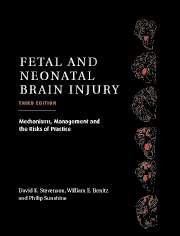Book contents
- Frontmatter
- Contents
- List of contributors
- Foreword
- Preface
- Part I Epidemiology, Pathophysiology, and Pathogenesis of Fetal and Neonatal Brain Injury
- Part II Pregnancy, Labor, and Delivery Complications Causing Brain Injury
- Part III Diagnosis of the Infant with Asphyxia
- Part IV Specific Conditions Associated with Fetal and Neonatal Brain Injury
- Part V Management of the Depressed or Neurologically Dysfunctional Neonate
- Part VI Assessing the Outcome of the Asphyxiated Infant
- 40 Assessment of preterm infants' neurobehavioral functioning: reliability, validity, normative data, and prediction to age two
- 41 Long-term follow-up of term infants with perinatal asphyxia
- 42 Appropriateness of intensive care application
- 43 Medicolegal issues in perinatal brain injury
- Index
- Plate section
40 - Assessment of preterm infants' neurobehavioral functioning: reliability, validity, normative data, and prediction to age two
from Part VI - Assessing the Outcome of the Asphyxiated Infant
Published online by Cambridge University Press: 10 November 2010
- Frontmatter
- Contents
- List of contributors
- Foreword
- Preface
- Part I Epidemiology, Pathophysiology, and Pathogenesis of Fetal and Neonatal Brain Injury
- Part II Pregnancy, Labor, and Delivery Complications Causing Brain Injury
- Part III Diagnosis of the Infant with Asphyxia
- Part IV Specific Conditions Associated with Fetal and Neonatal Brain Injury
- Part V Management of the Depressed or Neurologically Dysfunctional Neonate
- Part VI Assessing the Outcome of the Asphyxiated Infant
- 40 Assessment of preterm infants' neurobehavioral functioning: reliability, validity, normative data, and prediction to age two
- 41 Long-term follow-up of term infants with perinatal asphyxia
- 42 Appropriateness of intensive care application
- 43 Medicolegal issues in perinatal brain injury
- Index
- Plate section
Summary
Back in 1977, we began to develop a neurobehavioral assessment for preterm infants that would allow us to measure the effects of a longitudinal, randomized, controlled intervention study with preterm infants. In designing our assessment procedure we started from the premise that the most relevant and important goal of any intervention would be to facilitate the normality of the infants developmental course so that their maturity and ultimate development would not be too discrepant from that of full-term newborns within the normal range. Therefore, to assess the effects of our intervention, our prime objective was to use an instrument that could measure the differential maturity of functioning of randomly assigned experimental and control groups of preterm infants.
At the time, only very few assessments existed that measured the neurobehavioral maturity of premature newborns. Most of the ones available were techniques that measured gestational age and they were applicable only to infants within the first week after birth (e.g., Robinson, Dubowitz et al., and Finnström). The only assessments available in 1977 for measuring longitudinally the maturity of functioning of preterm infants were those by Amiel-Tison and Saint-Anne Dargassies.
Although these French neonatal neurologists systematically assessed and documented the maturational course of neural functions of preterm infants aged 28 weeks postconception to term, they illustrated and scored the age differences in infant functioning only in 2-week increments.
- Type
- Chapter
- Information
- Fetal and Neonatal Brain InjuryMechanisms, Management and the Risks of Practice, pp. 817 - 828Publisher: Cambridge University PressPrint publication year: 2003



